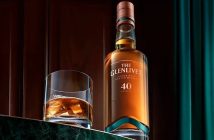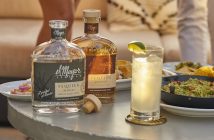“Sadly, I can’t claim much credit for this whisky. This whisky was distilled in 1969 and my parents weren’t even married in 1969. I did, however, swap stories with Eddie, who was around when this was casked, and it was funny to hear him tell of the quality control in the olden days. These days we have full chemistry and sensory labs on site; however, back then you had a warehouse man and a cooper, and they would have a wee dram and decide which ones they liked and which ones they didn’t. The ones they liked became single malts, the ones they didn’t became blends. This particular cask must have been pretty popular because out of the whole cask we’ve only managed to get 53 bottles. That makes it pretty special. Let’s taste it.”
The words we’d been waiting for. Glasses were passed round. I exchanged glances with the chaps. This was it.
The nose was unbelievably delicate and complex; the customary characteristics of wood smoke, peatiness and the citrus that had baffled me all evening were there but all of these were so subtle, muted by a creaminess. “You’re not going to taste a whisky,” Iain said. He’s right, I thought. “You’re going to taste mangoes, lychees, pink grapefruit…” Crikey, was this a whisky or a fruit salad? “It’s very soft, it acidulates the mouth…” It what? “It acidulates the mouth, it moistens the mouth. That tells you a lot about the cask. If it moistens the mouth, that’s characteristic of bourbon barrels. If a whisky dries the mouth, traditionally it’s been matured in European oak, usually sherry.”
There was another characteristic I noticed. In younger whiskies, the first note is often the smokiness, with citrus-y aftertastes, here the influences were reversed. The assault of fruit gave way to the gentle smokiness of the barrel. I turned to Jonesy. “That’s pretty good”, I said. He grinned. The first time all evening. “That’s pretty good,” he said back. And a smirk of satisfaction swept across his face.
It’s not simply the liquid in the bottle that makes for a £6,500 whisky. It’s the bottle itself. And the final flourish of the evening was the reveal of this work. As the velvet was drawn from the glass cabinet containing the bottle, I’m sure I heard a gasp from the gathering. Designed by two of Scotland’s premier glass-blowers, each bottle is unique, hand-blown and crafted using stones from the Islay shores, creating a sculpture inspired by the island’s rugged coastline. It’s finished with a hand-engraved solid silver collar. It was nothing I had expected and, if truth be told (they’re not giving me a free one, after all), it’s a little gaudy for my tastes but it is, indeed, a work of art. Much like the nectar inside it.
*For those readers who missed the irony in this paragraph I would like to stress that this was purely illustrative. Charles Tyrwhitt make the finest shirts this side of Jermyn Street. Demarquette’s chocolates are second to none. Richard Corrigan still burns a soufflé occasionally. But he’s not a bad chef otherwise.
To purchase a bottle of the 40-year-old vintage, please contact Bowmore directly.





1 Comment
Great story chaps, thoroughly enjoyed it. And it ended – or at least the bit that was fit to print ended – in a far more civilised manner than I feared from the opening few paragraphs.